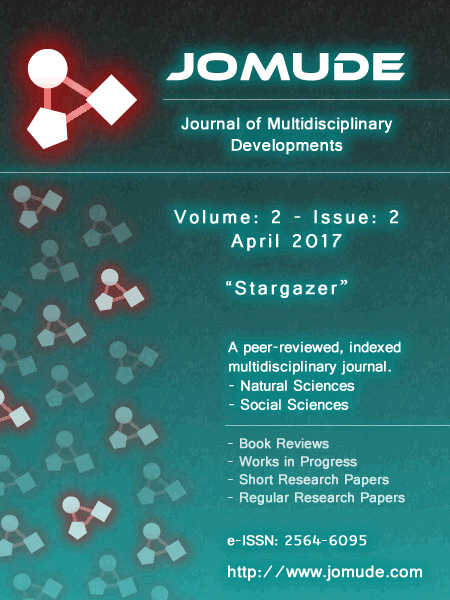Optimization and Investigation of the Design Parameters for Boric Acid Production from Colemanite Using the Ultrasound-Assisted Extraction Process
Main Article Content
Abstract
Article Details
Authors retain copyright and grant the journal right of first publication with the work simultaneously licensed under a Creative Commons Attribution License that allows others to share the work with an acknowledgement of the work's authorship and initial publication in this journal.
Authors are able to enter into separate, additional contractual arrangements for the non-exclusive distribution of the journal's published version of the work (e.g., post it to an institutional repository or publish it in a book), with an acknowledgement of its initial publication in this journal.
Authors are permitted and encouraged to post their work online (e.g., in institutional repositories or on their website) prior to and during the submission process, as it can lead to productive exchanges, as well as earlier and greater citation of published work (See The Effect of Open Access).
References
Bayca, S. U. (2013). Microwave radiation leaching of colemanite in sulfuric acid solutions. Separation and Purification Technology, 105, 24-32.
Bulutcu, A. N., Ertekin, C. O., & Celikoyan, M. K. (2008). Impurity control in the production of boric acid from colemanite in the presence of propionic acid. Chemical Engineering and Processing: Process Intensification, 47(12), 2270-2274.
Celik, M. S., Hancer, M., & Miller, J. D. (2002). Flotation chemistry of boron minerals. Journal of colloid and interface science, 256(1), 121-131.
Eymir Tekin, C., & Okur, H. (2011). Investigation of the Dissolution of Colemanite Ore in Water and Boric Acid Solutions Including Highly Acidic Ion Exchangers under Microwave Heating. Industrial & Engineering Chemistry Research, 50(21), 11833-11842.
Gür, A. (2007). Dissolution mechanism of colemanite in sulphuric acid solutions. Korean Journal of Chemical Engineering, 24(4), 588-591.
Helvacı, C., & Alonso, R. N. (2000). Borate deposits of Turkey and Argentina; a summary and geological comparison. Turkish Journal of Earth Sciences, 9(1), 1-27.
Joglekar, A. M., & May, A. T. (1987). Product excellence through design of experiments. Cereal foods world, 32(12), 857.
Kistler, R. B., & Helvaci, C. (1994). Boron and borates. Industrial minerals and rocks, 6, 171-186.
Koca, S., & Savas, M. (2004). Contact angle measurements at the colemanite and realgar surfaces. Applied surface science, 225(1), 347-355.
Künkül, A., Aslan, N. E., Ekmekyapar, A., & Demirkıran, N. (2012). Boric acid extraction from calcined colemanite with ammonium carbonate solutions. Industrial & Engineering Chemistry Research, 51(9), 3612-3618.
Kuskay, B., & Bulutcu, A. N. (2011). Design parameters of boric acid production process from colemanite ore in the presence of propionic acid. Chemical Engineering and Processing: Process Intensification, 50(4), 377-383.
Levent, S., Budak, A., Pamukoğlu, M. Y., & Gönen, M. (2016). Extraction of boric acid from tincal mineral by supercritical ethanol. The Journal of Supercritical Fluids, 109, 67-73.
Luque-Garcia, J. L., & de Castro, M. L. (2002). Continuous ultrasound-assisted extraction of hexavalent chromium from soil with or without on-line preconcentration prior to photometric monitoring. Analyst, 127(8), 1115-1120.
Okyay, T. O., & Rodrigues, D. F. (2014). Optimized carbonate micro-particle production by Sporosarcina pasteurii using response surface methodology. Ecological Engineering, 62, 168-174.
Ramić, M., Vidović, S., Zeković, Z., Vladić, J., Cvejin, A., & Pavlić, B. (2015). Modeling and optimization of ultrasound-assisted extraction of polyphenolic compounds from Aronia melanocarpa by-products from filter-tea factory. Ultrasonics sonochemistry, 23, 360-368.
Roldán-Gutiérrez, J. M., Ruiz-Jiménez, J., & De Castro, M. L. (2008). Ultrasound-assisted dynamic extraction of valuable compounds from aromatic plants and flowers as compared with steam distillation and superheated liquid extraction. Talanta, 75(5), 1369-1375.
Sert, H., Yıldıran, H., & Toscalı, D. (2012). An investigation on the production of sodium metaborate dihydrate from ulexite by using trona and lime. International Journal of Hydrogen Energy, 37(7), 5833-5839.
Taylan, N., Gürbüz, H., & Bulutcu, A. N. (2007). Effects of ultrasound on the reaction step of boric acid production process from colemanite. Ultrasonics sonochemistry, 14(5), 633-638.
Temur, H., Yartaşı, A., Çopur, M., & Kocakerim, M. M. (2000). The kinetics of dissolution of colemanite in H3PO4 solutions. Industrial & engineering chemistry research, 39(11), 4114-4119.
Ucbeyiay, H., & Ozkan, A. (2014). Two-stage shear flocculation for enrichment of fine boron ore containing colemanite. Separation and Purification Technology, 132, 302-308.
Yeşilyurt, M. (2004). Determination of the optimum conditions for the boric acid extraction from colemanite ore in HNO 3 solutions. Chemical Engineering and Processing: Process Intensification, 43(10), 1189-1194.
Yeşilyurt, M., Çolak, S., Çalban, T., & Genel, Y. (2005). Determination of the optimum conditions for the dissolution of colemanite in H3PO4 solutions. Industrial & engineering chemistry research, 44(10), 3761-3765.

